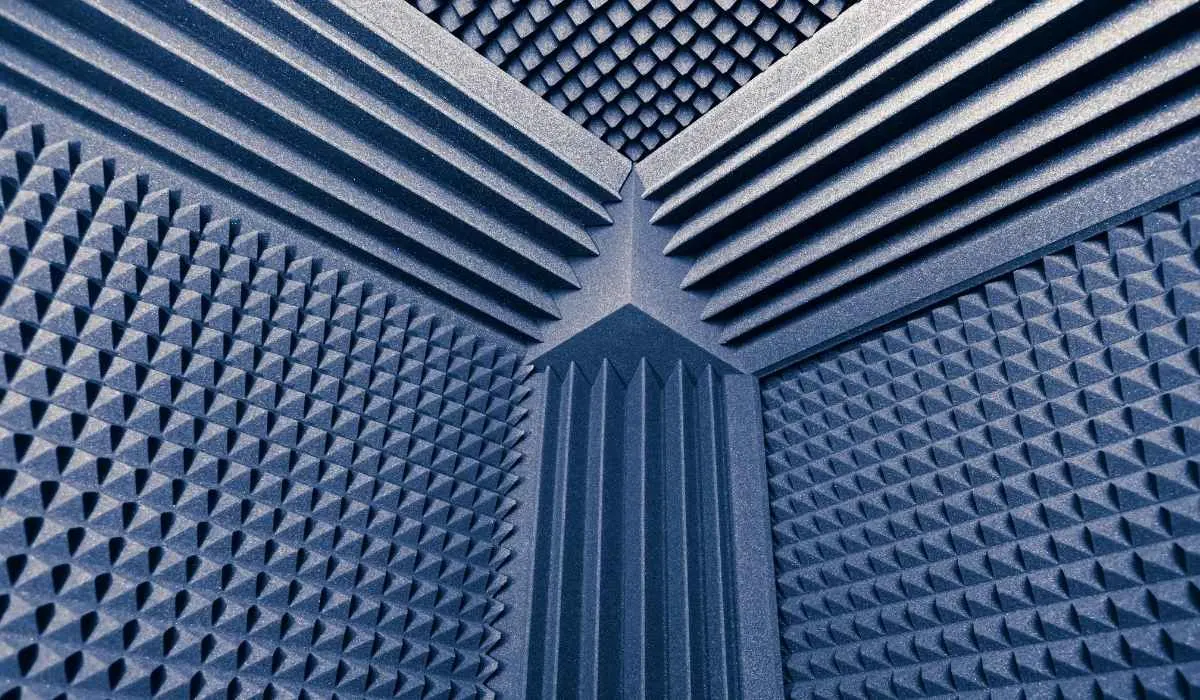When it comes to soundproofing a room, acoustic panels and foam are two of the most popular and effective tools you can use. These materials are used to absorb sound waves and improve the acoustic properties of the space.
Acoustic panels and foam have many benefits and some drawbacks. Although they’re pretty evenly matched in some regards, acoustic panels are generally better at enhancing the sound within a room. Foam, on the other hand, can be very effective at preventing sound from escaping.
There are many other factors to consider when comparing foam and acoustic panels, including the average cost, how effectively they reduce problem frequencies and the material’s longevity.
In this guide, you’ll learn about the key differences between acoustic panels and foam to choose the suitable material for your requirements.
Acoustic Panels vs Acoustic Foam – Overview
Acoustic panels and acoustic foam share the same two fundamental purposes – to improve a room’s sonic qualities and make it more soundproof.
Despite being designed for the same purposes there are many essential differences between the two varieties of acoustic materials. For example, acoustic panels generally come in larger sizes that cannot be altered and have a more appealing aesthetic design.
Acoustic foam is usually easier to customize and is, therefore, more versatile. The trade-off is that this material doesn’t generally look as nice as acoustic panels, which is reflected in the price.
The different qualities of acoustic panels and foam are also apparent regarding their impact on how a room sounds. This is where it gets a little more complicated, as both forms of acoustic treatment can be highly effective for different purposes.
Let’s look at the individual aspects of acoustic foam and panels so that we can directly compare their performance in each area.
Acoustic Treatment
Acoustic panels and foam are designed predominantly to absorb specific frequencies to improve the overall sound quality of a room.
When sound waves are outputted by a speaker or generated from playing an instrument or singing, they reflect off the surfaces in a room. The waves bounce around the walls, ceiling, tables, and windows until they eventually decay.
This process can cause specific sound frequencies to build up in particular areas of the room. The corner where the ceiling meets two walls is a common problem area for frequency build-up.
Acoustic panels and acoustic foam are highly absorbent so that when the frequencies reach them, they are dampened and prevented from bouncing around the room.
The best option when considering acoustic treatment is acoustic panels, but only if they are built to a high quality.
This is because the panels have a stretched layer of material across a frame, and the sound waves can be captured by the material very effectively so that they don’t bounce back around the room with the same intensity.
Spreading acoustic panels evenly around a room will improve the overall sound, particularly by absorbing many of the bass frequencies that tend to cause the most issues.
Acoustic foam is also a good choice for this purpose, but some may find it absorbing too much of the sound, resulting in an overly “dead” sounding room.
This may be desirable if you want a dry-sounding drum recording, but it isn’t ideal for mixing audio.

Soundproofing
One of the primary purposes of acoustic treatment is to soundproof a room. Soundproofing simply means preventing noise from escaping from the space so that it doesn’t sound loud outside.
Using materials like acoustic panels or foam is an excellent way to soundproof your room if you have a home theatre setup, a recording studio, or you want to play an instrument without disturbing others.
Although both are good options for soundproofing, the fact that acoustic foam is available in larger sizes generally makes it more effective for this purpose. This is because the more surface area you can cover with an absorbent material, the less sound will spill out of the room.
Acoustic panels will certainly soundproof a room to an extent, but because they come in set sizes, it’s more challenging to cover a large wall area. You can’t alter their shape to suit the room’s specific dimensions, making it harder to spread them out.
Acoustic foam can also be placed over a problem area of a room, such as where two walls meet or directly next to a door. These areas are where most of the sound will build up and can escape outside, potentially annoying anyone nearby.
Acoustic foam is the best option if you aim solely to soundproof a room. However, before you make your decision, there’s much more to consider.
Aesthetics
The visual aspects of acoustic treatment may not be as important to you as the sonic qualities. Still, if you’re setting up a room that will be used for recording, mixing, rehearsing, or simply listening to music, you probably want it to look good as well as sound good.
There’s one clear winner when it comes to aesthetics – acoustic panels. However, this is only the case if you choose high-quality panels, as some of the cheaper options can look untidy and sometimes a little tacky.
Acoustic foam is a practical material that you can place in almost any location within a room, but it generally doesn’t look tidy. It’s the kind of material some people may want to hide away as well as possible so that you don’t draw attention to it.
On the other hand, acoustic panels can be purchased in assorted colors to suit the room. Their square or rectangular design is easy to position on a wall with symmetry and consistency.
Indeed, there are ways that you can use acoustic foam creatively to make it look better. If you’ve got a good eye for interior design, acoustic foam can be made to look less of an eye sore within your room.
The issue is that most acoustic foam comes with ridged edges that protrude out and can be difficult to place on a wall subtly.
It’s possible to create your own acoustic panels to suit your room’s aesthetics more appropriately. I’ll provide more information on how you can do this in a later section.

Dimensions & Shapes
Acoustic panels are available in a few sizes and are generally square or rectangular in shape. The limited number of sizes available may be an issue if you need specific dimensions for your room.
Acoustic foam, on the other hand, is available in a wide range of sizes and shapes. You can get small squares of foam or larger pieces and combine different sizes to fill the required spaces.
If you want to cover larger areas, acoustic panels of the most extensive varieties are the best choice. You can get huge panels designed for live rooms and recording studios, spanning several square meters in area.
For smaller spaces, acoustic foam is available in 1 square ft panels. These can be slotted into gaps that larger acoustic panels would have no chance of fitting into.
This is the standard size that most acoustic foam panels come in. It’s easy to cover an entire wall or section of a room with these small panels by making larger squared areas using many of them.
It’s important to measure the space you want to cover with acoustic treatment so that you can choose the ideal size, whether you opt for the foam or the panels.
In some cases, it might be a good idea to combine acoustic panels with foam if you need to cover specific areas on a wall or ceiling, but this may make it more challenging on the cosmetic front.
Customizable Designs
Due to acoustic panels coming in set sizes and their design consisting of an outer frame filled with internal absorbent material, it’s much more difficult to customize them to fit into a specific space.
Acoustic foam can be easily cut into a custom shape to fit perfectly with the dimensions you need it to fill. For this reason, many DIY recording or mixing setups include acoustic foam over panels.
If you choose to make your own panels, you obviously have more freedom to customize them than if you purchase one of the few sizes they come in.
It’s actually not too difficult to make acoustic panels. You need an outer frame that is at least 6 inches deep, and then you simply stretch a robust cloth or other soft material around it.
You can then fill the inside of the cloth material with an absorbent material like wool or a small piece of foam, or you can simply leave it empty.
Custom-designing acoustic panels may be a good idea if you need certain sizes that aren’t easy to find. Foam is a much better option if you prefer to get your acoustic treatment up more quickly.
Cost
You can find expensive acoustic panels, or more affordable ones. The same can be said for acoustic foam – high quality options will cost you more than the cheaper, less quality options.
In general, acoustic panels are more expensive to buy than foam. This is because there’s more work that goes into producing the panels, and more varied materials are used to construct them.
Once the foam is manufactured, it only has to be cut into cubes and it is ready to sell. This simple process allows the brands that produce it to sell it for a relatively low cost compared to acoustic panels.
Acoustic panels are shaped and designed in a variety of ways, and so there’s a lot of variation of the price. Expensive panels may even have artwork printed on them for enhanced aesthetics.
Budget acoustic panels often have a self-adhesive back which is peeled off so that they can be easily stuck onto a wall or surface.
Acoustic Panels vs Foam – Summary
As you can see from the comparisons of the key aspects, there are pros and cons to both acoustic panels and foam.
Foam is a more practical option, as it can be easily tailored and resized to suit the specifics of your room.
Acoustic panels are undeniably easier on the eye, and for people who want to create a space that looks as good as it sounds, they’re generally a better option than foam when it comes to appearance.
The sonic qualities of panels and foam vary depending on the quality of the individual product in question, but on the whole, foam is more absorbent and will therefore treat your acoustic space more effectively.
It’s also difficult to find acoustic panels that are more affordable than acoustic foam, because the panels have a more complex manufacturing process that is reflected in their price tag.
It may be a good idea to combine the use of foam and acoustic panels if you want to ensure that you benefit from the qualities of both options.
Planning how you will lay out your acoustic treatment in a room is essential if you are to choose the best possible foam or acoustic panels to suit your aspirations for the room. This may involve measuring the space you have available or drawing out diagrams to plan the positions of the acoustic treatment.
Related Questions
What is the difference between acoustic panels and soundproofing?
Acoustic panels are generally made to improve the acoustic treatment of a room, while soundproofing is designed to prevent sound from escaping from the room. Panels can be effective at soundproofing too, though.
How do I stop noise escaping from a room?
The most effective way to prevent noise from escaping from a room is by installing absorbent soundproofing materials to stop the reverberation and reflection of sound waves before they leave the space. Placing thick curtains over any windows is also a good idea.
Do acoustic panels collect dust?
Due to being made from absorbent, soft materials, acoustic panels have a tendency to collect dust over time: It’s therefore recommended to vacuum them regularly to remove built up dust.
